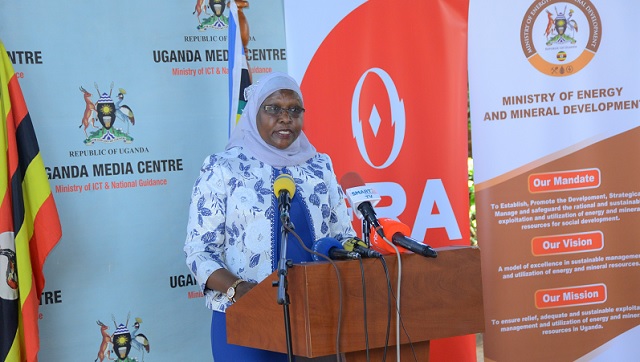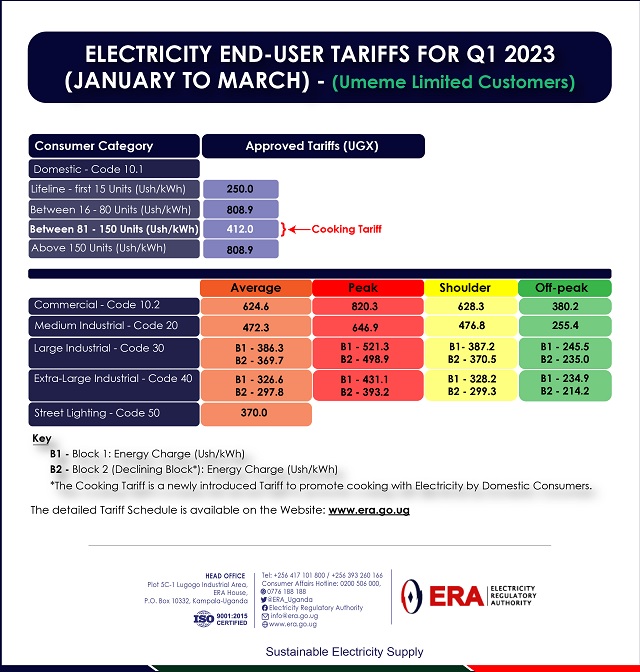
Kampala, Uganda | THE INDEPENDENT | The government has set electricity tariffs for the first quarter of 2023 beginning January to March. The new tariffs announced by the Chairperson of the Electricity Regulatory Authority-ERA, Dr, Sarah Kanaabi Wasagali, show that domestic users shall pay 250 Shillings for the first 15 units purchased in a month known as a lifeline and 808.9 Shillings for units above the lifeline.
This means there is no reduction in the lifeline tariff but a 1.5 percent reduction in the above lifeline units. Dr. Wasagali also announced that the commercial tariffs shall be reduced from 624.6 Shillings in the current last quarter of 2022 to 637.7 Shillings in the coming first quarter of 2023.
This signifies a reduction of 2.1 percent. Medium industrial tariffs have also been reduced by 2.1 percent from 482.3 Shillings in the current quarter to 472.3 for the first quarter of 2023. Large industrial and extra-large tariffs have both been reduced to 0.6 percent, the earlier from 388.5 to 386.3 and the latter from 328.5 to 326.6 Shillings.
Electricity tariffs for street lights have been maintained at 370 Shillings.

Dr. Wasagali said that the tariffs have been set based on different factors such as the appreciation of the Uganda Shillings against the dollar from 3810.74 at the time tariffs for the current fourth quarter of 2022 were determined to 3738.33 by 30th November 2022. She also says that they expect Electricity demand to grow at an annual rate of approximately 8.3 percent in 2023.
Dr. Wasagali also said that the government shall maintain the domestic cooking tariff which is domestic electricity consumption between 81 to 150 units per month. Under the cooking tariff, domestic consumers who use between 81 to 150 consecutively for three months are charged under the lifeline tariff instead of the above lifeline. This is intended to motivate people to use electricity for cooking instead of other forms of energy such as charcoal or firewood.
In a bid to increase the usage of electricity in the country, the government shall also implement the hybrid customer connection framework where the cost of a pole connection has been reduced from 720,883 shillings to 470,000 shillings.
The Minister for Energy and Mineral Development Ruth Nankabirwa said that the government had issued a subsidy of 250,883 shillings to enable more Ugandans to get connected to the power grid.
She also said that the government working with the Uganda Development Bank shall provide an interest-free credit line of 270,000 shillings for people who cannot afford a lump-sum payment of 470,000 shillings to acquire a pole. This means that if a person can’t pay 470,000 Shillings at once to be connected, they can pay an initial 200,000 Shillings, are connected, and then pay the remaining 270,000 Shillings in installments. Nankabirwa says that the government shall make a 15 percent charge on the electricity purchased by such people for them to be able to pay back the loan in a maximum of eight years.
The above offer however works for only people who need one pole to get connected. Those who need more poles shall be catered for under other projects the government also intends to implement in 2023. One of the projects includes the establishment of 150 mini-grids to provide clean energy to areas far from the main grid with approximately 5 to 6MWp total installed capacity across the country.
According to the 2018 International Hydro-power Association report, Uganda has an installed capacity of 743 MW. Uganda expects to commission the 600 MW Karuma Hydro-power Plant next year and with this connect the West Nile region to the transmission grid in March 2023.
The Minister said that Karuma will not only enhance the country’s power generation capacity but also strengthen and improve the stability of the power supply grid. She says this plant shall also offer one of the lowest tariffs since the government funded 15 percent of its construction.
*****
URN
 The Independent Uganda: You get the Truth we Pay the Price
The Independent Uganda: You get the Truth we Pay the Price




13.6 units at shs.13000 is completely out of ranges given by umeme. And I have just paid with debt of shs. 96. In addition to amonthly service fee of about 4000. u need to revise these costs bse electricity is not imported.
I dont understand yaka charges these days, i paid 30000 And was just given 30units.. Implying a unit is above 800ugx. Has the charges only been increased 4 my house alone?
I would like to know the real cost of power unit under domestic consumption?
What I see daily is 1,000per unit because I buy for 50,000# I get 50 units,, why stealing from us maybe it’s based on regions
Yaka Tarrifs and charges are not clear enough, its just confusing.
We are paying far much than normally explained.